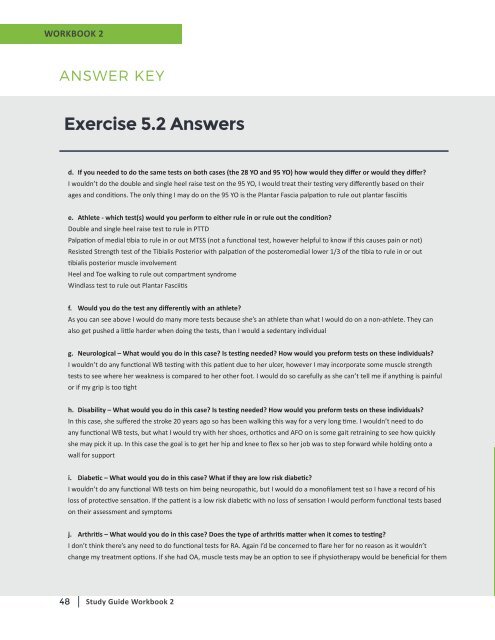OER - Pathomechanics, Conditions & Diseases
Create successful ePaper yourself
Turn your PDF publications into a flip-book with our unique Google optimized e-Paper software.
WORKBOOK 2<br />
ANSWER KEY<br />
Exercise 5.2 Answers<br />
d. If you needed to do the same tests on both cases (the 28 YO and 95 YO) how would they differ or would they differ?<br />
I wouldn’t do the double and single heel raise test on the 95 YO, I would treat their testing very differently based on their<br />
ages and conditions. The only thing I may do on the 95 YO is the Plantar Fascia palpation to rule out plantar fasciitis<br />
e. Athlete - which test(s) would you perform to either rule in or rule out the condition?<br />
Double and single heel raise test to rule in PTTD<br />
Palpation of medial tibia to rule in or out MTSS (not a functional test, however helpful to know if this causes pain or not)<br />
Resisted Strength test of the Tibialis Posterior with palpation of the posteromedial lower 1/3 of the tibia to rule in or out<br />
tibialis posterior muscle involvement<br />
Heel and Toe walking to rule out compartment syndrome<br />
Windlass test to rule out Plantar Fasciitis<br />
f. Would you do the test any differently with an athlete?<br />
As you can see above I would do many more tests because she’s an athlete than what I would do on a non-athlete. They can<br />
also get pushed a little harder when doing the tests, than I would a sedentary individual<br />
g. Neurological – What would you do in this case? Is testing needed? How would you preform tests on these individuals?<br />
I wouldn’t do any functional WB testing with this patient due to her ulcer, however I may incorporate some muscle strength<br />
tests to see where her weakness is compared to her other foot. I would do so carefully as she can’t tell me if anything is painful<br />
or if my grip is too tight<br />
h. Disability – What would you do in this case? Is testing needed? How would you preform tests on these individuals?<br />
In this case, she suffered the stroke 20 years ago so has been walking this way for a very long time. I wouldn’t need to do<br />
any functional WB tests, but what I would try with her shoes, orthotics and AFO on is some gait retraining to see how quickly<br />
she may pick it up. In this case the goal is to get her hip and knee to flex so her job was to step forward while holding onto a<br />
wall for support<br />
i. Diabetic – What would you do in this case? What if they are low risk diabetic?<br />
I wouldn’t do any functional WB tests on him being neuropathic, but I would do a monofilament test so I have a record of his<br />
loss of protective sensation. If the patient is a low risk diabetic with no loss of sensation I would perform functional tests based<br />
on their assessment and symptoms<br />
j. Arthritis – What would you do in this case? Does the type of arthritis matter when it comes to testing?<br />
I don’t think there’s any need to do functional tests for RA. Again I’d be concerned to flare her for no reason as it wouldn’t<br />
change my treatment options. If she had OA, muscle tests may be an option to see if physiotherapy would be beneficial for them<br />
48 Study Guide Workbook 2


